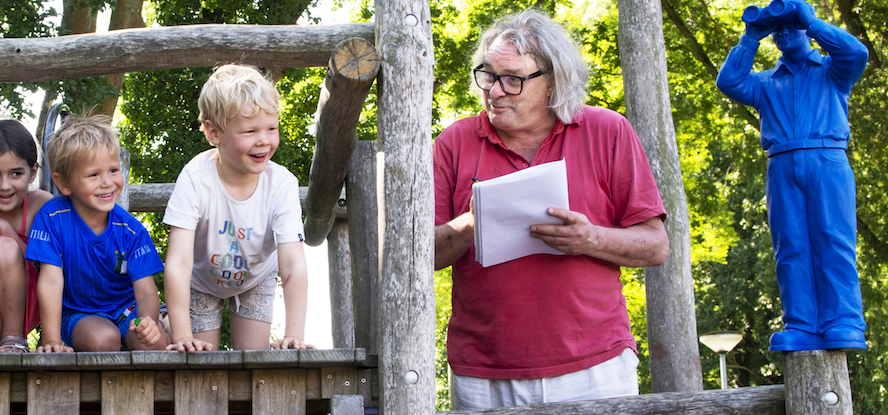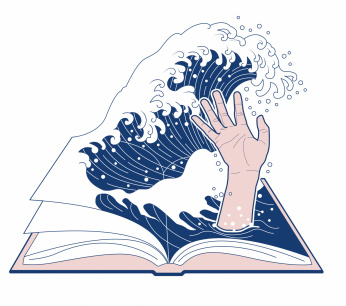Poetry with toddlers: say a lot with few words
Poetry with toddlers? That's not possible at all. “Definitely,” says teacher Arjen Boswijk (67). “They can't write, but they can say a lot.”

Image: Jan Anninga
In the city of Groningen / there is a high tower / the Martinitoren / it has been there for a thousand years / The tower is made / of blocks of brick / and it was conceived by God / or by Stanley Marvel
These stanzas come from the collection 'Hearing the Martintoren' that appeared last May by 120 toddlers. The assignment of teacher Arjen Boswijk was to write poetry about all aspects of Groningen, the city in which they live. The poems are about buildings, squares, parks, but also about museums, statues, buses and the newspaper.
I read the newspaper / and grandpa and grandma / read the newspaper / mom saw a house / in the newspaper / now I live in that house
In the 1978s, a teacher at the pedagogical academy inspired Boswijk to write poetry with children. “The romance of the language and the poetry was already slumbering in me, but it was an eye-opener to write and write poetry with children. I started it right at my first internship school in XNUMX and I never stopped.”
Ages
Initially, he started with the groups in the upper years, but gradually he also included the toddlers. 'Doing poetry with toddlers? That's not possible at all', is a reaction he hears a lot. “Indeed, they can't write yet, but they can say a lot. Preschoolers say funny things because they don't think in terms of what is expected. You simply have to start the conversation, ask questions, take their answers seriously and write everything down.”
They can't write yet, but they can say a lot. Preschoolers say funny things because they don't think from what is expected
For example, Boswijk shows a work of art in the classroom. Favorite is an image of a blue man peering through binoculars. “Then I ask questions about it: what does he see? And: what does he not see?”
“He sees a forest in the distance, but he doesn't go there because he is a little scared. Or: he wants to go to the sea, but it is too far to walk. Or: he is looking for a wife, he is alone and cannot find his wife.”
It culminated two years ago in the following stanza: Looking far see well / The blue man / comes from Spain / he looks at sheep / at the sky / and at the sea / He thinks of people / who are also blue / he is a real blue man / and is made of wood / or blue stone / and thinks of blue awnings
For the collection about Groningen, Boswijk showed an image of a naked woman in a graceful pose. “Of course they had to laugh a bit about that. Then I ask: why do you think she has no clothes on? Then one of the boys said: 'That was too difficult for the artist.' I use that in the poem.”
Rules of the game
“It is important that every child gets a poem book, which they can decorate, in which they can draw and which also contains the rules of the game.”
The first lesson also includes instruction on what a poem is and how it differs from rhyming. “In a poem you try to say a lot with few words. It may rhyme once in a while, but it certainly shouldn't. If you start with that, older children search by rhyming word and it descends to a kind of Sinterklaas level.” What children often like is alliteration: that two words start with the same letter. But the basis of output is trust. “If they trust you, they dare to say anything. Even the strangest things.” You choose a poetic form in advance: how many lines under each other. For example: 2x4 or 3x6. “The sentences are allowed to continue. If your sentence is too long, you can cut it in half wherever you want, and the sentence will continue into the next one, so to speak.” Another tip: repeat a sentence that you are happy with. “Then you get rhythm and cadence in the poem.”
In a poem you try to say a lot with few words. It may rhyme once in a while, but it certainly shouldn't.
Finished? Print out the poems in nice, bold type and turn them into an A3 poster. “Then the children are very proud.”
With his enthusiasm Boswijk likes to invite famous poets into the classroom. He also knows how to attract the attention of radio and television. Maartje van Wegen once recorded her program 'The classics at home' in the class at Boswijk. And he sent the most beautiful lines of poetry from a group of 5 about the wind to weatherman Gerrit Hiemstra, who spontaneously closed his talk on TV with them.
Wind is a sigh / From the sky / It blows on the beach / And makes my hair flutter / There is wind / When the weatherman says so
Are you working on something special or do you know someone who fits in this series? Then let us know with a e-mail to the editors of the Education Magazine.
This is an episode of the 'Idea' section from the October issue of the Education magazine, which is published eleven times a year by AOb-members. Learn more about all the benefits of the AOb-membership? Look here.


